Fable Legends Early Preview: DirectX 12 Benchmark Analysis
by Ryan Smith, Ian Cutress & Daniel Williams on September 24, 2015 9:00 AM ESTGraphics Performance Comparison
With the background and context of the benchmark covered, we now dig into the data and see what we have to look forward to with DirectX 12 game performance. This benchmark has preconfigured batch files that will launch the utility at either 3840x2160 (4K) with settings at ultra, 1920x1080 (1080p) also on ultra, or 1280x720 (720p) with low settings more suited for integrated graphics environments.
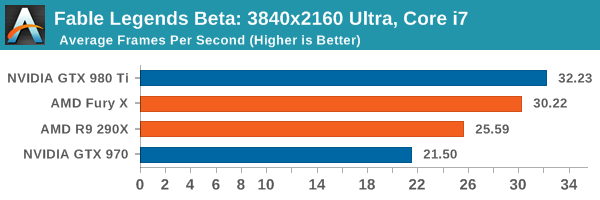

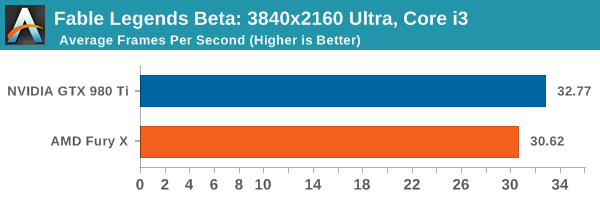
When dealing with 3840x2160 resolution, the GTX 980 Ti has a single digit percentage lead over the AMD Fury X, but both are above the bare minimum of 30 FPS no matter what the CPU.

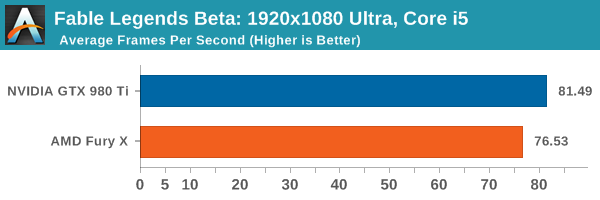
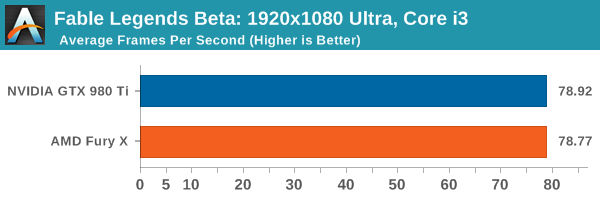
When dealing with the i5 and i7 at 1920x1080 ultra settings, the GTX 980 Ti still has that single digit percentage lead, but at Core i3 levels of CPU power the difference is next to zero, suggesting we are CPU limited even though the frame difference from i3 to i5 is minimal. If we look at the range of cards under the Core i7 at this point, the interesting thing here is that the GTX 970 just about hits that 60 FPS mark, while some of the older generation cards (7970/GTX 680) would require compromises in the settings to push it over the 60 FPS barrier at this resolution. The GTX 750 Ti doesn’t come anywhere close, suggesting that this game (under these settings) is targeting upper mainstream to lower high end cards. It would be interesting to see if there is an overriding game setting that ends up crippling this level of GPU.
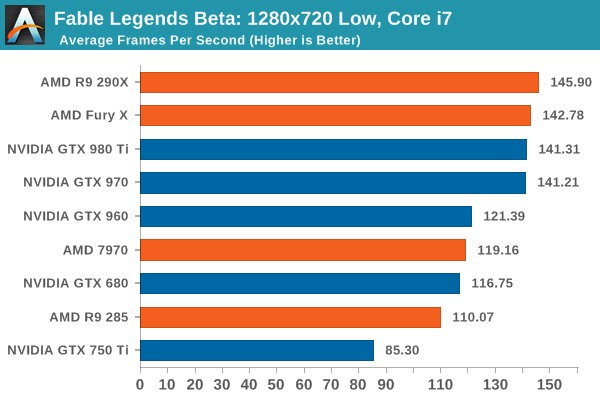
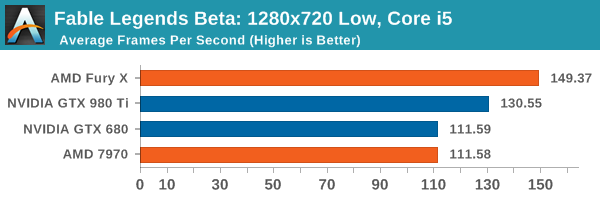
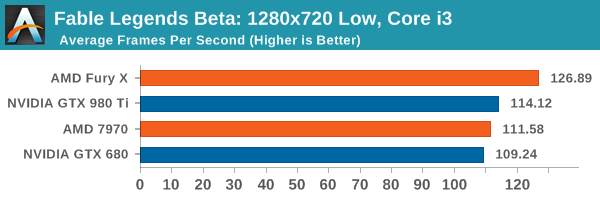
At the 720p low settings, the Core i7 pushes everything above 60 FPS, but you need at least an AMD 7970/GTX 960 to start going for 120 FPS if only for high refresh rate panels. We are likely being held back by CPU performance as illustrated by the GTX 970 and GTX 980 Ti being practically tied and the R9 290X stepping ahead of the pack. This makes it interesting when we consider integrated graphics, which we might test for a later article. It is worth noting that at the low resolution, the R9 290X and Fury X pull out a minor lead over the NVIDIA cards. The Fury X expands this lead with the i5 and i3 configurations, just rolling over to the double digit percentage gains.










141 Comments
View All Comments
Alexvrb - Friday, September 25, 2015 - link
Ship them both to the East Coast and set up a Review Office / Beach Resort, complete with community events!zimanodenea - Thursday, September 24, 2015 - link
My Asus m5a97 has an option to do this.mdriftmeyer - Thursday, September 24, 2015 - link
Time to develop in a test harness of equal merits and scope across the globe for the reviewers. To do less is unprofessional. The whole point of a test harness is not to ductape simulations but to cover all bases.Spunjji - Friday, September 25, 2015 - link
Well said. This isn't some tinpot organisation, is it? ;)Drumsticks - Thursday, September 24, 2015 - link
That's a shame. I'd really like to see that comparison. With the improvements Zen should, in theory, bring, it could really give AMD its best chance in years to get some wind under its sails.beck2050 - Thursday, September 24, 2015 - link
A little too early to worry about. Hopefully both companies will improve when 12 becomes standard issue.DrKlahn - Thursday, September 24, 2015 - link
Epic has always worked closely with Nvidia and used their hardware, so the only thing that surprises me is that the gap doesn't favor Nvidia more. It's very early to make any predictions, but there are some interesting conversations on other forums about how both architectures behave in different situations. Nvidia's architecture does appear to have issues in some asynchronous workloads. What little evidence we have says this may be an issue in some games.My own opinion is that with Nvidia's market dominance we will see most developers try to avoid situations where problems occur. As an AMD owner my main hope is that we see DX12 squeeze out proprietary codes and level the playing field more. I'm also happy that the latest Unreal engine appears to run well on both vendors hardware.
jiao lu - Thursday, September 24, 2015 - link
not only close working relationship . the Unreal 3/4 use Nvidia Physics sdk outright. Epic engine is terribly optimized for console right now. basically it is PC engine, churn out pc demo now and then . Now far fewer AAA studio use unreal 4 like they do with unreal 3 in the ps 3/xbox 360 era. I am very much suspicious unreal 5 is not mult-threaded rendering enough , use dx 12 like do dx 11 before.Midwayman - Thursday, September 24, 2015 - link
Well, the xbox one is using AMD hardware and dx12. That's probably a bigger reason to keep it neutral than more nvidia share on the PC.Spunjji - Friday, September 25, 2015 - link
The PS4 is also using the same AMD GCN 1.0 architectures for CPU and GPU